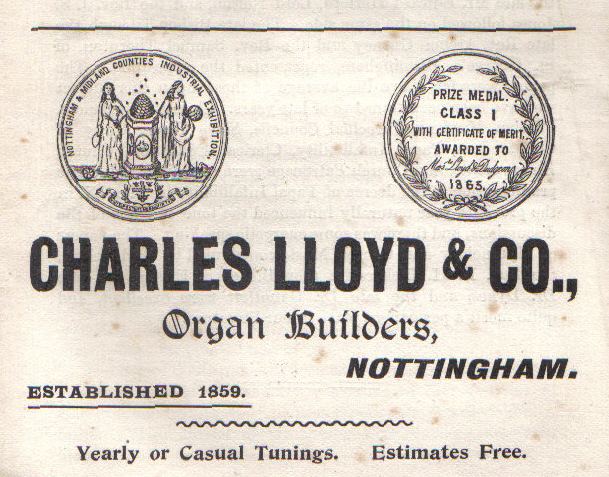Charles Lloyd (8 September 1835 - 8 October 1908) was a pipe organ builder based in Nottingham who flourished between 1859 and 1908.
He was born in London on 8 September 1835, the son of Samuel Lloyd a shoemaker. He was baptised on 18 March 1838 in St Pancras New Church. In 1851, aged 15, he was described as "apprentice organ builder".
He married Mary Ann Dennison (b ca. 1841 in Nottingham) in 1864.
Charles Lloyd had previously worked for Samuel Groves of London. Lloyd set up in business first with Lorenzo Valentine and shortly afterwards with Alfred Dudgeon. Their workshop was at 52A Union Road, near the centre of Nottingham. They were soon at work installing organs in places of worship in and around the Nottingham area. Lloyd was commissioned by Sydney Pierrepont, 3rd Earl Manvers of Holme Pierrepont, to construct and exhibit a two manual and pedal organ at the Birmingham Trades Exhibition in 1865. It won Lloyd a gold medal award for its workmanship and tone. After the exhibition, the organ was moved back to Nottingham and installed in St. Edmund's Church, Holme Pierrepont.
Lloyd & Dudgeon were partners until the death of Albert Dudgeon on 6 February 1874. The company name was then changed to C. Lloyd & Co, Church Organ Builders, Nottingham.
When the Great Central Railway was brought to Nottingham in 1896, land occupied by the Lloyd business had to be cleared to make way for the Victoria Station. Lloyd moved to 79 Brighton Street, St Ann’s.
In 1909, his son, Charles Frederick Lloyd took over the business and it continued until 1928 with no change to the name. The company was then acquired by Roger Yates.
Company names and addresses
Lloyd and Valentine 1859 - 1860, Bilbie Street, NottinghamLloyd and Valentine 1861, 19 William Street, and 6 Sherwood Street, NottinghamLloyd and Dudgeon 1862 - 1876, 52A Union Road, NottinghamC. Lloyd & Co 1876 - 1896, 52A Union Road, NottinghamC. Lloyd & Co 1896 - 1928, 79 Brighton Street, St Ann’s, NottinghamThe first was Ernest Wragg of Carlton who, after his period of training, set up as an organ builder himself in 1894 on Carlton Road, Thorneywood, as E. Wragg & Son, Organ Builders.
The second was John Compton, born in Measham, Leicestershire. He entered into organ building first at Birmingham, then with Brindley of Sheffield, then in Nottingham under Charles Lloyd. When free of his apprenticeship in 1902, along with an organ builder named Musson of Woodborough Road, Nottingham, they became Compton & Musson.
Union Workhouse, Melton Mowbray, Leicestershire 1859Scalford Church 1859Melton Mowbray Wesleyan Church 1859St George's Church, Leicester 1860 additionsAll Saints Church, Loughborough 1862 additionsHoly Trinity Church, Bulcote, Nottinghamshire 1862St Ann's Church, St Ann's Well Road, Nottingham 1864All Saints' Church, Nottingham 1865St. Paul's Church, Hyson Green, Nottingham 1865St. Edmund's Church, Holme Pierrepont 1865St Mary's Church, Evedon, Lincolnshire 1866St Mary's Church, Cromford, Derbyshire ca. 1868 additionsBroad Street Baptist Church, Nottingham 1869All Saints' Church, Mackworth, Derbyshire 1870St. Andrew's Church, Nottingham from St Mary's Church, Nottingham 1871All Saints' Church, Findern, Derbyshire 1876St James’ Church, Swarkestone, Derbyshire ca. 1876Thoresby Church 1876St Helen's Church, Burton Joyce, 1879Congregational Church, Middleton-by-Wirksworth, Derbyshire, ca 1880Holy Trinity Church, Middleton-by-Wirksworth, Derbyshire, ca 1880Shaw Lane Methodist Church, Milford, Derbyshire, ca 1880St. Thomas' Church, Nottingham 1882Chellaston Methodist Church, High Street, Chellaston, Derbyshire 1882Riddings Congregational Church, Alfreton, Derbyshire 1883St James' Church, Riddings 1885 (enlargement)Addison Street Congregational Church, Nottingham 1885Holloway Methodist Church, Church Street, Holloway, Derbyshire ca. 1885St Luke's Church, Hickling (restoration) 1886St. Bartholomew's Church, Nottingham 1887St. Barnabas Church, Derby, 1889St Lawrence's Church, North Wingfield, Derbyshire, 1890St Mary and St Barlock's Church, Norbury, Derbyshire 1890St. Sebastian's Church, Great Gonerby, Lincolnshire, 1890St Michael's Church, Hoveringham 1891Wood Street Primitive Methodist Church, Ripley, Derbyshire, 1892Somercotes Church, Alfreton, Derbyshire 1894St Bartholomew's Church, Clay Cross, Derbyshire 1894St. Andrew's Church, Barrow Hill, Derbyshire 1895Draycott Methodist Church, Market Street, Draycott, Derbyshire ca. 1897St. Giles Church, West Bridgford, Nottingham 1899 at a cost of £500. It was a three manual and pedal with choir organ prepared for. It was rebuilt and enlarged by Henry Willis & Sons in 1952, and removed in 1993.Ebenezer Methodist Church, Newhall, Derbyshire ca. 1900 (in 2008 installed in Swadlincote Baptist Church)Christ Church, St Albans, Hertfordshire, ca. 1900 rebuilt and enlargedMethodist Church, Bingham Road, Cotgrave, Nottinghamshire 1900Free Church, Upper Broughton, Nottinghamshire ca. 1900St John the Evangelist, Hazelwood, Derbyshire 1902All Saints' Church, Kirk Hallam Derbyshire 1904St. Michael and All Angels, Alvaston, Derbyshire 1904Albion Congregational Church, Sneinton, Nottingham 1905Carlton Methodist Church, Nottingham 1905St Thomas' Church, Brampton, Derbyshire 1906St. John's Church, Ripley, Derbyshire 1906 (now in St. Mary the Virgin, Stoke Bruerne, Northamptonshire)St John's Church, Newhall, Derbyshire 1909St. Mary's Church, Greasley, Nottinghamshire 1910
